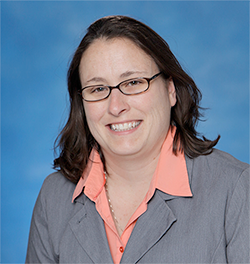DR. MELISSA JEAN BOPP
Dr. Melissa Jean Bopp specializes in community-based influences on physical activity, health disparities, and public health approaches to physical activity. Her work has included studies of physical activity choices by college students, including how physical activity resources in neighborhoods and student housing affect physical activity and fitness behaviors. 1 She recently co-authored Bicycling for Transportation: An Evidence-Base for Communities, published in 2018 by Elsevier.

HER ANGLE » BIKING & WALKING PROVIDE PHYSICAL ACTIVITY THAT FIGHTS DISEASE
According to Dr. Bopp, the benefits of biking and walking are wide-ranging and extensive. What interests her most are the health benefits associated with participation in active transportation. Regular active travel is associated with a decreased risk of chronic disease, as well as significant physical and mental health benefits. Given the rising costs of healthcare and the economic burden of poor health, prevention is key, and active transportation can play a valuable role.
Her work attempts to understand the factors that impact walking and biking behavior. Like any behavior, the choice to engage in walking and biking is a complex one, and it is important to look at things comprehensively. Dr. Bopp views walking and biking for transportation as an easy “sell” to fitting physical activity into busy lives. Time is the most common barrier to why people are not active, but according to Dr. Bopp, “we all have to travel places on a daily basis, so why not kill two birds with one stone–opt to walk or bike AND get your daily dose of activity?”
HER ANGLE » CURRENT DATA SHOWS GAPS AND NEEDS FOR FURTHER RESEARCH
The Benchmarking Report helps provide a rationale for her work by showing current data on walking and biking in the United States. These data highlight the gaps in knowledge that lead us to our next project, proposal, or joint venture with community partners.
One continuing gap is a lack of data on active travel among ethnic minorities, populations with lower socio-economic status, and people living in rural areas. These groups tend to have higher rates of lifestyle-related chronic disease, so it would be helpful to understand their relationship with biking and walking. Such understanding is necessary because it is essential to draw on existing research of the influences for active travel in a given population in order to develop a tailored, more salient message for the group you are trying to target, according to Dr. Bopp. “Messages are always better received and more meaningful–therein more likely to change behavior–if a group feels like the message is built for them,” she says.
Shaffer, K., Bopp, M. J. (Author, 20%), Sims, D., Papalia, Z., & Bopp, C. M. The relationship of living environment with behavioral and fitness outcomes by sex: an exploratory study in college-aged students. International Journal of Exercise Science., retrieved at https://www.ncbi.nlm.nih.gov/pmc/articles/ PMC5421984/

